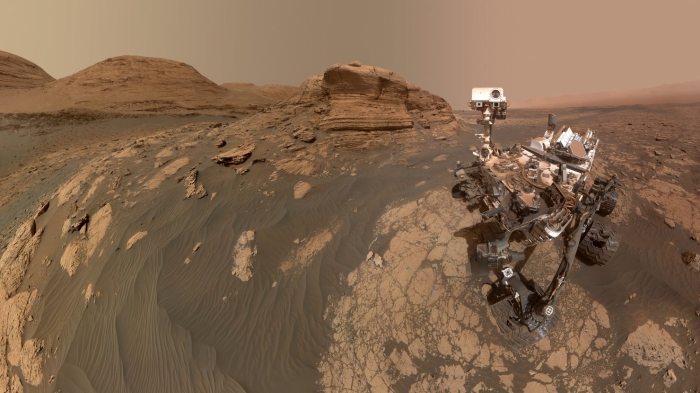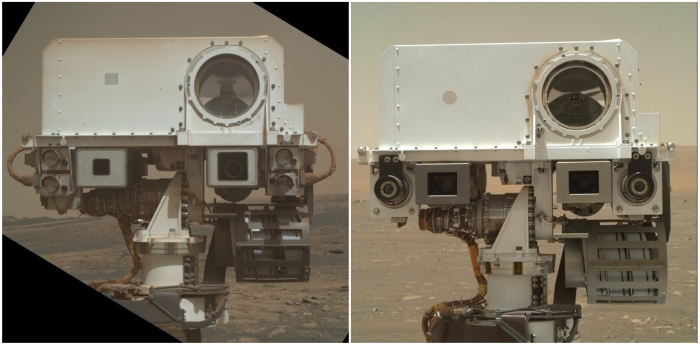Science
NASA's New Mars Rover Just Took One of The Sweetest Extraterrestrial Selfies Ever – ScienceAlert

Perseverance hasn’t even been on Mars for two months, and already the latest in red planet rovers is picking up some of Curiosity’s excellent habits.
No, not science; well, at least not just science. Percy is proving just as adept as her predecessor at snapping brilliant selfies, as the most recently sent images show.
As the rover settles into its new home in the Jezero Crater, it’s been sending back images of its surroundings, including parts of itself. We’re still waiting for a full-body pic, but on April 6, using the SHERLOC WATSON camera attached to its robotic arm, Perseverance took images of its ‘head‘ and ‘face‘.
“Oh hey… didn’t see you there…” (NASA/JPL-Caltech)
In official terms, this is the mast, on top of which is mounted cameras the rover uses to image Mars.
The large round one is the SuperCam, equipped with a laser and a spectrometer for analyzing rock samples; below it, the two rectangular lenses are the Mastcam-Z, which takes high-definition color, 3D and panoramic images and video of Percy’s surroundings.
At the very bottom of the images, jutting out of Percy’s ‘neck’, is the Mars Environmental Dynamics Analyzer, which is equipped with sensors to monitor Mars’ weather – including the quantity and particle size of the planet’s ubiquitous red dust.
Portrait of the Artist as a Young Bot
WATSON digital image
Jezero Crater, Mars, 2021 pic.twitter.com/Gtw81npIJB— NASA’s Perseverance Mars Rover (@NASAPersevere) April 6, 2021
The first weather report from MEDA has only just come in from the day after Percy touched down on Mars, showing that the temperature in the crater was minus 20 degrees Celsius, dropping to minus 25.6 degrees Celsius within 30 minutes. The atmosphere was also cleaner than the atmosphere in the Gale Crater, home to Curiosity, at the same time.


Curiosity, meanwhile, is still beavering away, and sending selfies of its own. On 26 March, it took a panoramic image of itself and the landscape around it, including a rocky outcrop called Mont Mercou.
You can see, from the image, just how dusty a rover can get after eight and a half years on Mars: Curiosity is coated in a layer of the stuff, and it has collected on her chassis.
We have no fear of Curiosity – or Perseverance, for that matter – going the way of Opportunity, which lost power after dust obscured its solar panels. Both Curiosity and Perseverance are powered by the radioactive decay of plutonium, which can keep them going even when raging dust storms circle the entire planet.


The next step for the Perseverance mission is the flight of Mars helicopter Ingenuity. Ingenuity detached from Percy on 3 April, and has survived its first step – a freezing night on Mars, which can damage delicate components.
The first flight is scheduled to take place sometime on or after 11 April, after which – beginning at around around 3:30 am EDT Monday 12 April – NASA will host a livestream confirming the attempt. You can find details on where to watch on the NASA website.
Science
SpaceX sends 23 Starlink satellites into low-Earth orbit


|
|
April 23 (UPI) — SpaceX launched 23 Starlink satellites into low-Earth orbit Tuesday evening from Space Launch Complex 40 at Cape Canaveral Space Force Station in Florida.
Liftoff occurred at 6:17 EDT with a SpaceX Falcon 9 rocket sending the payload of 23 Starlink satellites into orbit.
The Falcon 9 rocket’s first-stage booster landed on an autonomous drone ship in the Atlantic Ocean after separating from the rocket’s second stage and its payload.
The entire mission was scheduled to take about an hour and 5 minutes to complete from launch to satellite deployment.
The mission was the ninth flight for the first-stage booster that previously completed five Starlink satellite-deployment missions and three other missions.





Science
NASA Celebrates As 1977’s Voyager 1 Phones Home At Last


|
|
Voyager 1 has finally returned usable data to NASA from outside the solar system after five months offline.
Launched in 1977 and now in its 46th year, the probe has been suffering from communication issues since November 14. The same thing also happened in 2022. However, this week, NASA said that engineers were finally able to get usable data about the health and status of its onboard engineering systems.
Slow Work
Fixing Voyager 1 has been slow work. It’s currently over 15 billion miles (24 billion kilometers) from Earth, which means a radio message takes about 22.5 hours to reach it—and the same again to receive an answer.
The problem appears to have been its flight data subsystem, one of one of the spacecraft’s three onboard computers. Its job is to package the science and engineering data before it’s sent to Earth. Since the computer chip that stores its memory and some of its code is broken, engineers had to re-insert that code into a new location.
Next up for engineers at NASA’s Jet Propulsion Laboratory in California is to adjust other parts of the FDS software so Voyager 1 can return to sending science data.
Beyond The ‘Heliopause’
The longest-running and most distant spacecraft in history, Voyager 1, was launched on September 5, 1977, while its twin spacecraft, Voyager 2, was launched a little earlier on August 20, 1977. Voyager 2—now 12 billion miles away and traveling more slowly—continues to operate normally.
Both are now beyond what astronomers call the heliopause—a protective bubble of particles and magnetic fields created by the sun, which is thought to represent the sun’s farthest influence. Voyager 1 got to the heliopause in 2012 and Voyager 2 in 2018.
The Pale Blue Dot is a photograph of Earth taken Feb. 14, 1990, by NASA’s Voyager 1 at a distance of … [+]
NASA/JPL-Caltech
Pale Blue Dot
Since their launch from Cape Canaveral, Florida, aboard Titan-Centaur rockets, Voyager 1 and Voyager 2 have had glittering careers. Both photographed Jupiter and Saturn in 1979 and 1980 before going their separate ways. Voyager 1 could have visited Pluto, but that was sacrificed so scientists could get images of Saturn’s moon, Titan, a maneuver that made it impossible for it to reach any other body in the solar system. Meanwhile, Voyager 2 took slingshots around the planets to also image Uranus in 1986 and Neptune in 1989—the only spacecraft ever to image the two outer planets.
On February 14, 1990, when 3.7 billion miles from Earth, Voyager 1 turned its cameras back towards the sun and took an image that included our planet as “a mote of dust suspended in a sunbeam.” Known as the “Pale Blue Dot,” it’s one of the most famous photos ever taken. It was remastered in 2019.





Science
NASA hears from Voyager 1, the most distant spacecraft from Earth, after months of quiet
|
|
CAPE CANAVERAL, Fla. (AP) – NASA has finally heard back from Voyager 1 again in a way that makes sense.
The most distant spacecraft from Earth stopped sending back understandable data last November. Flight controllers traced the blank communication to a bad computer chip and rearranged the spacecraft’s coding to work around the trouble.
NASA’s Jet Propulsion Laboratory in Southern California declared success after receiving good engineering updates late last week. The team is still working to restore transmission of the science data.
It takes 22 1/2 hours to send a signal to Voyager 1, more than 15 billion miles (24 billion kilometers) away in interstellar space. The signal travel time is double that for a round trip.
Contact was never lost, rather it was like making a phone call where you can’t hear the person on the other end, a JPL spokeswoman said Tuesday.
Launched in 1977 to study Jupiter and Saturn, Voyager 1 has been exploring interstellar space – the space between star systems – since 2012. Its twin, Voyager 2, is 12.6 billion miles (20 billion kilometers) away and still working fine.





-



 Health19 hours ago
Health19 hours agoRemnants of bird flu virus found in pasteurized milk, FDA says
-



 Health23 hours ago
Health23 hours agoBird flu virus found in grocery milk as officials say supply still safe
-
News15 hours ago
Amid concerns over ‘collateral damage’ Trudeau, Freeland defend capital gains tax change
-
Art19 hours ago
Random: We’re In Awe of Metaphor: ReFantazio’s Box Art
-



 Investment23 hours ago
Investment23 hours agoTaxes should not wag the tail of the investment dog, but that’s what Trudeau wants
-
News24 hours ago
Peel police chief met Sri Lankan officer a court says ‘participated’ in torture – Global News
-
Art13 hours ago
The unmissable events taking place during London’s Digital Art Week
-
Media18 hours ago
Vaughn Palmer: B.C. premier gives social media giants another chance




